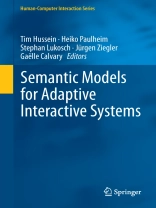Providing insights into methodologies for designing adaptive systems based on semantic data, and introducing semantic models that can be used for building interactive systems, this book showcases many of the applications made possible by the use of semantic models.
Ontologies may enhance the functional coverage of an interactive system as well as its visualization and interaction capabilities in various ways. Semantic models can also contribute to bridging gaps; for example, between user models, context-aware interfaces, and model-driven UI generation. There is considerable potential for using semantic models as a basis for adaptive interactive systems. A variety of reasoning and machine learning techniques exist that can be employed to achieve adaptive system behavior. The advent and rapid growth of Linked Open Data as a large-scale collection of semantic data has also paved the way for a new breed of intelligent, knowledge-intensive applications.
Semantic Models for Adaptive Interactive Systems includes ten complementary chapters written by experts from both industry and academia. Rounded off by a number of case studies in real world application domains, this book will serve as a valuable reference for researchers and practitioners exploring the use of semantic models within HCI.
Daftar Isi
Preface.- UI²Ont – A Formal Ontology on User Interfaces and Interactions.- Generating Models of Recommendation Processes out of Annotated Ontologies.- Cognitive Semantic Categories as a Basis for a Prototype Adaptive Information System.- A Semantic Model for Adaptive Collaboration Support Systems.- A Semantics-Based, End-User-Centered Information Visualization Process for Semantic Web Data.- PASTREM: Proactive Ontology Based Recommendations for Information Workers.- Visualizing Search Results of Linked Open Data.- A Context-Aware Shopping Portal Based on Semantic Models.- Semantic Models for Interactive Systems: The Case of Tagging and Folksonomies.- User Interaction Templates for the Design of Lifelogging Systems.












